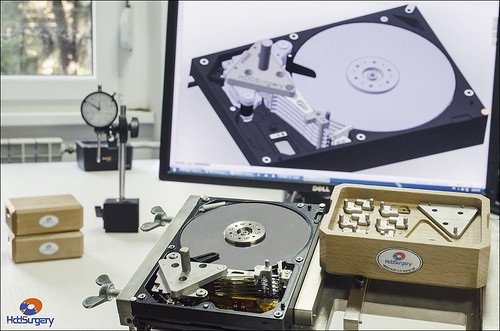Head replacement tools from HddSurgery
Head replacement process refers to the process of replacing defective HDD heads with the heads from identical and functional hard disk drive. This process must be performed in order to recover data from disks that have suffered from head crush failure.
Process of replacing damaged HDD heads with functional ones is pretty complex task, especially if you consider risk of damaging HDD platters, which may cause permanent data loss. Various methods and techniques were used to perform head replacement process, with different percentage of success and high chances that something will go wrong.
However, all of these methods demanded a lot of experience and technical skills. Still, the process remained liable to mistakes as a consequence of lack of standardized procedure, even if performed by experts. Idea behind HddSurgery head replacement tools was to make head replacement process safe by introducing strictly defined procedure and providing quality equipment to support it.

Figure 1: From idea to solution - head replacement tool development in HddSurgery
HddSurgery tools background
Idea behind HddSurgery head replacement tools was born in HelpDisc Data recovery company, with goal of making head replacement process easier and safer. HddSurgery head replacement tools started with solution for Maxtor DM9 and DM10 series. As the response from data recovery community was highly positive, work and development continued.
Head replacement solutions for great number of modern HDDs followed, so today HddSurgery tools support head replacement process on following HDD brands - Maxtor, Seagate, Western Digital, Samsung and Hitachi.
During the years of development, capacity of hard drives has grown exponentially. This constant growth, imposed by the needs of market, was followed with various solutions from leading HDD manufacturers.
Basic principle of HDD functioning hasn't changed, however its mechanics, especially design of its heads, magnets and motor sustained a lot of modifications. Effort of manufacturers, to increase capacity and performance in comparison to the competition, resulted in a situation that now we have great number of different HDD mechanics.
HddSurgery nomenclature
In accordance with the facts above, the number of HddSurgery head replacement tools has grown, so the nomenclature was created for all future tools, so that it will be easier to distinguish them.
For example, HDDS Sea 7200.10/.9/.8/ES p2-3
HDDS – HddSurgery brand mark
Sea – 3 letter mark for HDD Brand (Sea – Seagate, WDC - Western Digital, HGST - Hitachi…)
7200.10/.9/.8/ES – Families of hard drives that this tool supports (7200.10, 7200.9, 7200.8, ES)
p2-3 – Marks the number of platters this tool will work on (p2-3 stands for drives with 2 or 3 platters)
HDD classification
From the aspect, which is the most important for head replacement (and consequently for HddSurgery tools design), modern hard drives are divided into two groups:
1. HDDs which park their heads on "landing zones"
2. HDDs which park their heads on a ramp

Figure 2: Parking principles of HDD heads; Left - "landing zones", Right - ramp parking
While turned off, hard disk drive has to stop and park its heads on a safe location in its interior, so data stored on the platters won't be threatened and where its highly-sensitive heads can't be damaged.
"Landing zones" are areas on the HDD platters, closest to the axis of their rotation, on which data can't be stored and which are predicted only for parking of the heads while hard drive is not working. Surface of these "landing zones" is rougher than the rest of the platters, so there is no danger that heads will affix to them as a result of adhesion.
Safe head replacement on this type of hard drives means that the heads have to be lifted while lying on the safe "landing zone" and transferred above surface of the platters (where any contact can lead to permanent data loss) to the area beyond them, where entire head assembly can be safely dismounted from HDD casing. Mounting of donor heads in a patient drive is done in the same way, however with reverse order of steps.
Ramp parking of HDD heads was implemented to replace "landing zones" parking principle. This principle implies existing of separate part - ramp, located outside HDD platters, on which heads are parked after hard drive is turned off. Almost all hard drives made in last few years operate on this principle.
Head replacement on these drives includes preventing of mutual contact between the heads after their sliding-off the ramp and during their dismounting from HDD casing. Heads remained separated by the tool until their mounting on patient drive ramp.
Our next articles will describe head replacement process on these two groups of hard drives, by using HddSurgery head replacement tools.
Get updated with the news from HddSurgery on Facebook, Twitter, Google + and LinkedIn.
